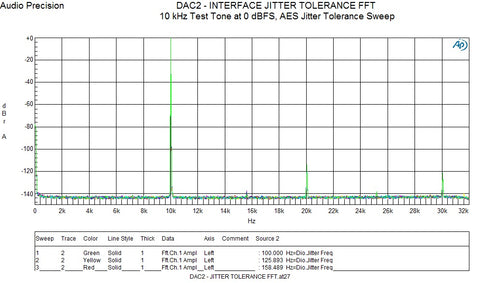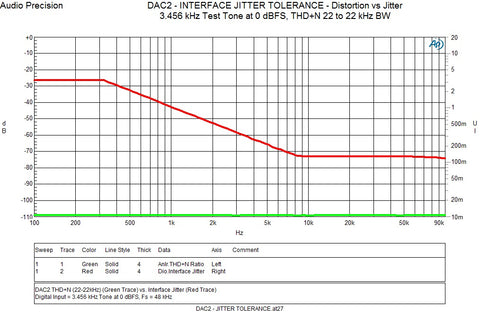Free shipping on USA orders over $700. Low-cost shipping to Canada.
Jitter in A/D Converters
by John Siau October 03, 2014

Jitter in A/D Converters
All A/D converters have two forms of jitter: Conversion clock jitter, and interface jitter. These two forms of jitter are very different and have very different consequences. Conversion clock jitter adds permanent distortion to the audio signal, interface jitter does not. In most cases, interface jitter cannot be recorded, and the interface jitter of you A/D converter will not become a part of your recording. The Benchmark DAC1 is a very useful tool for removing virtually all interface jitter. Interface jitter must be removed if the true sonic character of an A/D converter (including A/D conversion clock jitter) is to be evaluated.
But, isn't interface jitter a part of the sonic character of an A/D?
Surprisingly the answer is no! Here is why: Any interface jitter present at the output of an A/D converter is lost when the data is recorded to hard disk, tape, or optical disk. It is highly unlikely that any of the interface jitter on your A/D converter will ever find it's way into your recordings. However, all of the A/D converter's conversion clock jitter will find its way into your recordings.
When does A/D interface jitter effect what I hear?
If you connect an A/D converter directly to a D/A converter that lacks the ability to remove interface jitter, the interface jitter produced by the A/D will become conversion clock jitter inside the D/A converter. When this happens, the A/D interface jitter will color the audio produced by the D/A converter. Most D/A converters recover a conversion clock from the digital audio interface. These D/A converters must recover a jitter-free conversion clock from the digital interface. Most D/A converters do not have adequate clock recovery for true 24-bit performance. With inadequate clock recovery, interface jitter will become conversion clock jitter, and the audio produced by the D/A converter will not be an accurate analog representation of the digital data. In contrast, the DAC1 is immune to interface jitter, and it will allow you to hear the conversion clock performance of the A/D converter.
Why does my A/D sound different after I record it?
If an A/D -> D/A connection sounds different than an A/D -> record -> playback -> D/A connection, your D/A converter is at fault. Let's examine the process: Upon recording, the A/D interface jitter is removed while the A/D conversion jitter is preserved. Upon playback, new interface jitter will be introduced by the playback device. This new interface jitter usually has absolutely no correlation to the interface jitter at the output of the A/D converter. If the playback D/A converter can remove interface jitter, both connections will sound the same. If the D/A converter cannot remove interface jitter, the results of your tests will never be repeatable.
Most D/A converters are adversely affected by interface jitter. Most D/A converters recover a clock from the digital audio interface or from a dedicated WC or SC connection. Usually these clock connections are filtered with a PLL to remove some of the interface jitter. There a very large variations in the quality of the PLL circuits found in professional audio equipment. The quality of the clock recovery in a D/A converter can be measured in terms of jitter attenuation, intrinsic jitter, PLL corner frequency, etc.

The Benchmark DAC1 uses an SRC to isolate the interface clock from the conversion clock. The conversion clock on the DAC1 is driven directly from a fixed-frequency, low intrinsic jitter, crystal oscillator. Data is passed between the two clock domains using the SRC. The SRC process achieves the equivalent of a 1 Hz PLL corner frequency, and has jitter attenuation that greatly exceeds very good PLL designs.
The DAC1 should allow critical analisis of the conversion clock performance of A/D converters without the misleading effects of interface jitter. Your studio can't ship interface jitter in the finished product, but it will always ship the A/D conversion clock jitter. Interface jitter is a local problem.

External References
 "Jitter"
"Jitter"
Also in Audio Application Notes

How Loud is the Distortion from Your Power Amplifier?
by John Siau August 08, 2025
Would you put a Washing Machine in your Listening Room?
If the answer is no, you may be surprised to discover that the distortion produced by your power amplifier may be louder than the noise produced by a major appliance.
Don't believe me? Take a look at Stereophile's test reports:
We selected 7 power amplifiers from Stereophile's top list of recommended amplifiers.
We took Stereophile's "THD+N vs. Power" plots for each, and replotted the data in a format that shows the loudness of the THD+N at the listening position.
The results are shocking!
Amplifier THD+N is louder than expected!
The distortion from your amplifier may be louder than a washing machine on the spin cycle, or it may be totally silent. How does yours perform? The answer is hidden in Stereophile's THD+N plots.
This application note reveals the hidden truth:
"The Distortion from your Power Amplifier may be Louder than a Washing Machine!"
I know, it sounds crazy, but this is what the measurements show!

Interpolator Overload Distortion
by John Siau November 20, 2024
Most digital playback devices include digital interpolators. These interpolators increase the sample rate of the incoming audio to improve the performance of the playback system. Interpolators are essential in oversampled sigma-delta D/A converters, and in sample rate converters. In general, interpolators have vastly improved the performance of audio D/A converters by eliminating the need for analog brick wall filters. Nevertheless, digital interpolators have brick wall digital filters that can produce unique distortion signatures when they are overloaded.
10% Distortion
An interpolator that performs wonderfully when tested with standard test tones, may overload severely when playing the inter-sample musical peaks that are captured on a typical CD. In our tests, we observed THD+N levels exceeding 10% while interpolator overloads were occurring. The highest levels were produced by devices that included ASRC sample rate converters.

Audiophile Snake Oil
by John Siau April 05, 2024
The Audiophile Wild West
Audiophiles live in the wild west. $495 will buy an "audiophile fuse" to replace the $1 generic fuse that came in your audio amplifier. $10,000 will buy a set of "audiophile speaker cables" to replace the $20 wires you purchased at the local hardware store. We are told that these $10,000 cables can be improved if we add a set of $300 "cable elevators" to dampen vibrations. You didn't even know that you needed elevators! And let's not forget to budget at least $200 for each of the "isolation platforms" we will need under our electronic components. Furthermore, it seems that any so-called "audiophile power cord" that costs less than $100, does not belong in a high-end system. And, if cost is no object, there are premium versions of each that can be purchased by the most discerning customers. A top-of-the line power cord could run $5000. One magazine claims that "the majority of listeners were able to hear the difference between a $5 power cable and a $5,000 power cord". Can you hear the difference? If not, are you really an audiophile?

